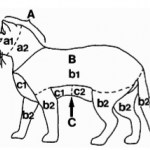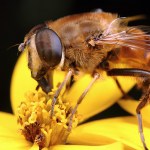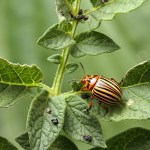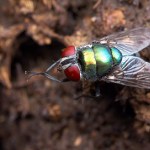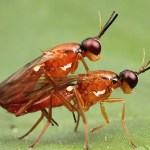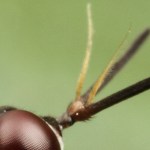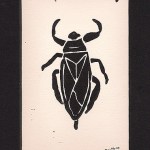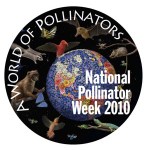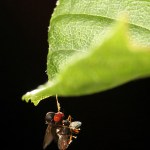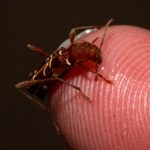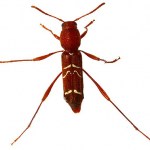insects
I've got a new piece over at the Scientific American Guest Blog:
On Friday, March 11, Japan was rocked by an earthquake. People were displaced, a nuclear reactor was in trouble, and the world watched as a tsunami flooded Japan, threatened the islands of the Pacific, and ultimately hit the western coasts of North and South America. Chris Rowan pointed out that "Very little of the devastation resulting from this earthquake was from the initial shaking. This is partly because of Japan's stringent building codes. But mainly because any damage from the seismic waves that sent skyscrapers in Tokyo…
Watch this video and it might appear as if that beetle is being operated via remote control.
But wait. IT IS. The critter is a bit of a cyborg actually - part june bug, part computer. The man behind the zombie cyborg beetles is Michel Maharbiz, an associate professor in the Department of Electrical Engineering and Computer Science at the University of California, Berkeley. I met him last week at an event on the Science of Cyborgs organized by the Science and Entertainment Exchange.
When these arthropods are in the "pupa" stage, they get implanted with electrodes designed to stimulate the…
Whether you're a dog, a cat, or a grad student who hasn't been home to shower for a few days, fleas are a major problem. They make skin itch. And NOTHING is worse than itchy skin.
But...
Do you know WHERE the fleas are? Where they like to hang out and guard their little flea eggs? Where's the best place for a flea to get a decent night's sleep, or a delicious snack? These are important questions. Lucky for us, Hsu, Hsu, and Wu of the Department of Entomology at National Taiwan University have the answers. And this paper, dear readers, is pure blogging GOLD.
Now, if you wanted to find out…
The old man crouched slightly as he took small tiny steps forward towards the woman's ass. I didn't see what was in is raised right hand, it was hidden from my view by his body draped with a colorful sarong. He crept closer, still crouched and still silent. She didn't see him coming, but when he finally struck the woman hardly seemed to notice. His hand, it turn out, bore what looked like a hand broom of the type used to sweep the dirt floors of the mud huts and open barazas, but smaller, cleaner, and cut somewhat differently. He used it to strike a fly off her bottom and when the surprised…
I've heard of "carrion beetles" but this is more like a "carry-on beetle":
Amanda and I were outside the cabin in Cass County, Minnesota last week, cutting pieces of plywood for sub flooring, and we saw this creature among the debris. At first I thought it was some kind of wasp covered with tiny spiders, but on further investigation it turned out to be a beetle covered with mites. When we first saw it, there were many more mites than in this photo, and they were virtually roiling on the insect's surface. It looked almost as though the insect was foaming.
We captured it for later…
Replacing floors is a total exercise routine. Moving furniture out of the way, ripping up whatever is there, measuring and cutting new sub flooring, carting around heavy sheets of plywood, tacking and nailing, and so on and so forth works every single muscle in one's body. That's what we did last weekend. Also, I was able to demonstrate my special technique for testing if a particular floor is safe, or if it is so rotted out that it has to be replaced; You stand on it bouncing up and down a little bit and if you crash through to the basement, that part of the floor was bad.
Saw the…
"But wait," you say. "Anteaters aren't pets!" Well, I didn't think so either. But Salvador Dali had a pet anteater. And that's good enough for me.
Figure 1: Salvador Dali taking his pet anteater for a stroll. (Source)
The Giant Anteater, Myrmecophaga tridactyla, only eats ants and termites, making it a myrmecophage. (Hey, Alex Wild, now I get what Myrmecos means!) In 1984, a researcher named Kent Redford was interested in the foraging behaviors of the giant anteater, and the relationship between these anteaters and their prey, colonies of highly social insects. So Redford went to Brazil to…
The Triassic is old. This book is new. That is a hard to beat combination.
Let's see ... The Triassic is about here:
(You can also look it up in this PDF file supplied by the USGS.
It is situated between two major extinction events, and is especially interesting because it is during this period that modern day ecological systems and major animal groups took a recognizable form. The preceding Permian, if contrasted with modern day, would form a very stark contrast while the Triassic would be at least somewhat more recognizable.
But of course the Triassic was in many ways distinct,…
Eristalis, the drone fly
Urbana, Illinois
Easily mistaken for a bee, Eristalis is in fact a clever mimic capable of luring many an unsuspecting observer into the land of amusing taxonomy fail.
But the structure of the antennae, the broad attachment of the abdomen to the thorax, and the presence of only a single pair of wings mark it as a fly.
I took this photo in bright sunlight, although it doesn't look that way from the black backdrop. This dramatic lighting effect is achieved by using such a small aperture (f/13) and a fast shutter speed (1/250 sec) that almost no ambient light reaches…
Leptinotarsa decemlineata
Urbana, Illinois
Meet the Colorado Potato Beetle.
If I had to make a list of ten insects all people should know, I'd probably put this one on it. Leptinotarsa decemlineata is a walking case study in evolutionary ecology.
Anyone with a potato patch will recognize this large, pin-striped beetle as a particularly voracious consumer of potato leaves. And that's true- the insect is a major agricultural pest. But it has only been eating potato plants for 150 years or so. Before that, L. decemlineata was an obscure insect found in the mountains of western North America…
The trailer for Shaun of the Dead.
Not all zombies are created equal. The most popular zombie archetype is a shambling, brain-eating member of the recently deceased, but, in recent films from 28 Days Later to Zombieland, the definition of what a zombie is or isn't has become more complicated. Does a zombie have to be a cannibal corpse, or can a zombie be someone infected with a virus which turns them into a blood-crazed, fast-running monster?
For my own part, I have always preferred the classic George Romero zombies from the original Dawn of the Dead and Day of the Dead films (as well as…
Forensic entomologists, of course.
These are the strong-stomached folks who study the arthropod fauna that colonizes dead flesh. Their knowledge of insect taxonomy, ecology, and development can be used to provide estimates of the time and conditions of death. Or zombification, in the present case.
Hypothetically, suppose a zombie shuffles along to my house at horrifying rate of 1 km/hr.
On arrival, I note that the zombie is infested with final instar larvae of the blow fly Phormia regina. Under our current warm summer weather conditions, it takes at least 5 days for the maggots to reach that…
Wasps, hornets, and other Hymenoptera may live nearly solitary lives, live in huge colonies, or something in between. The European hornet, Vespa crabro, lives in a colony consisting of one queen mated to a single male. In Hymenoptera, females are typically diploid (having genes from both parents) while males are typically haploid (having genes only from the female parent). If you draw a diagram of this and stare at it for a long time, you may come to the same conclusions that Bill "Buzz Off" Hamilton came to several years ago. A female would benefit genetically from helping her mother…
Loxocera cylindrica rust fly (Diptera: Psilidae)
Urbana, Illinois
The unmistakable antennae on these amorous insects mark them as psilid flies, and commentator Chris Grinter (of The Skeptical Moth) correctly surmised the species as Loxocera cylindrica. Nine points to Chris, and one to FormicidaeFantasy who was the first to pick the order.
This brings us to the end of June and to the announcement of the overall mystery points winner for the month:
Ted MacRae, of the excellent entomology blog Beetles in the Bush, has accumulated ten points and is entitled to either a guest blog post here on…
Ok. Now you guys have asked for it. Apparently the mysteries haven't been quite obscure enough.
So here you go. A real challenge:
One point for order, three points for family, three points for genus, and three for species. Points are awarded for the first correct guess in each category.
The cumulative points winner for the month of June will win either 1) any 8x10 print from my insect photo gallery, or 2) a guest blog post on the (safe-for-work) topic of their choosing.
Lethocerus medius, Linoleum block print
by the Dragonfly Woman
I've been meaning to mention Dragonfly Woman's insect blog, and now I've got an excuse. Chris Goforth- the Dragonfly Woman- is an aquatic entomologist and a friend of mine from when I worked at the University of Arizona. Recently, she sent this lovely print of a giant water bug.
Chris's blog is a thoughtful repository of info on all things insect and water-dwelling. For instance, how to tell the difference between dragonflies and damselflies. And, insect metamorphosis.
And now, she also crafts insect art. Awesome.
Have you wondered about the buzz in the air this week? Why the world seems to tingle with the excitement of little wings and millions of jointed legs?
No? Well, you're probably on the wrong drugs.
Anyway. This week is National Pollinator Week here in the U.S., where we take time to appreciate the fact that many plants wouldn't be able to have sex and set fruit if not for the multitudes of animals that visit their flowers.
I know. It's June 21-27- the week you've all been waiting for. The Moths! The Flies! The Bees! The Butterflies! Even the Bats, and the Birds!
Many local groups are…
A dagger fly (Diptera: Empididae), eating a fly it caught.Shawnee National Forest, Illinois
Among the insects, one lineage in particular excels in the air: Diptera, the flies. These animals have evolved a gyroscopic control system that's faster and more efficient than the standard insect sensory system, and as a consequence the flies are the most agile fliers on our planet. Their numbers include some spectacularly maneuverable aerial predators such as the fly pictured here, hanging from a leaf to consume its prey.
Photographing these subjects posed two problems. First, flies are highly…
[The following is a guest post by Rob Mitchell]
Rob here, back again with your answer to this week's mystery... not that you need it! And here I thought I was being tricky. Six points to FormicidaeFantasy for hitting the order, family, and genus, and another four to Gordon Snelling for making quick work of the specific epithet.
This beetle is a female Neoclytus tenuiscriptus, an uncommon little denizen of the American southwest (or the Mexican northwest, depending on where you're standing). According to Hovore's '83 monograph, the larvae bore in Baccharis, and specifically, can be found…
[the following is a guest post from Rob Mitchell]
Hi folks - Rob Mitchell here, guest blogger extraordinaire and your temporary replacement for Alex while he celebrates a recent age-related milestone.
My job tonight is to provide you entomology sleuths with a mystery, so take a look here at exhibit A:
Who is this gangly gal? Let's say we give points for her order (1), family (2), genus (3), and species (4).
As always, the cumulative points winner for the month of June will win either 1) any 8x10 print from Alex's insect photo gallery, or 2) a guest blog post on the (safe-for-work) topic…
